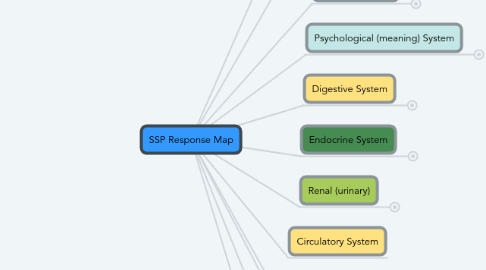
1. Respiratory System
1.1. dyspnea
1.2. apnea
1.3. breathholding
1.4. shallow breathing
1.5. hyperventilation
2. Circulatory System
2.1. blood pressure
2.2. heart rate variability/RSA
2.3. vasacular inflammation
3. Skeletal System
4. Circulatory System
5. Nervous System
5.1. CNS central nervous system
5.1.1. Brain
5.1.1.1. Brainstem
5.1.1.1.1. Circadian rhythms
5.1.1.2. Midbrain
5.1.1.2.1. hypothalamus
5.1.1.3. Cortex
5.1.2. Spinal cord
5.2. Sensory system
5.2.1. Spinal nerves
5.2.2. Receptors
5.2.2.1. Thermoreceptors
5.2.2.2. Chemoreceptors
5.2.2.3. Photoreceptors
5.2.2.4. Mechanoreceptors
5.3. Autonomic nervous system-brainstem origination
5.3.1. Parasympathetic nervous system Social engagement
5.3.1.1. Cranial Nerves I-XII
5.3.1.1.1. I Olfactory
5.3.1.1.2. II Optic
5.3.1.1.3. III Oculomotor
5.3.1.1.4. IV Trochlear
5.3.1.1.5. V Trigeminal
5.3.1.1.6. VI Abducens
5.3.1.1.7. VII Facial
5.3.1.1.8. VIII Vestibulocochlear
5.3.1.1.9. IX Glossopharyneal
5.3.1.1.10. X Vagus
5.3.1.1.11. XI Spinal Accessory
5.3.1.1.12. XII Hypoglossal
5.3.1.1.13. Secretions
5.3.2. Sympathetic nervous system mobilisation
5.3.2.1. Skeletal/motor muscles
5.3.2.1.1. intention-driven movement
5.3.2.1.2. reflex-driven movement
5.3.2.2. Stress response
5.3.2.2.1. stress hormones
5.3.2.2.2. mobilization
5.3.2.2.3. bronchoconstriction
5.3.2.2.4. increased heart rate
5.3.2.2.5. epigastric activity
5.3.2.2.6. bowel motility
5.3.2.2.7. vasodilation
5.3.2.2.8. dysautonomias
5.3.2.3. Homeostatis
5.4. Enteric nervous system (gut)
6. Psychological (meaning) System
6.1. Anxiety
6.1.1. Fears/phobias
6.1.2. Obsessions
6.1.2.1. Ruminative thought
6.1.2.2. Compulsions
6.1.3. Reactive movements
6.1.3.1. Flapping
6.1.3.2. Spinning
6.1.3.3. Rocking
6.1.3.4. Picking
6.1.4. Physiological signs
6.1.4.1. Biomarkers
6.1.4.1.1. HRV
6.1.4.1.2. RSA
6.1.4.1.3. Respiratory rhythm
6.1.4.1.4. Blood pressure
6.1.4.1.5. Cortisol levels
6.1.4.1.6. Galvanic skin response
6.1.4.2. Biorhythms
6.1.4.2.1. Sleep
6.1.4.2.2. Endocrine
6.1.4.2.3. Organ activation
6.1.5. Distorted self sense
6.2. Trauma Sequela
6.2.1. Flashbacks
6.2.2. Nightmares
6.2.3. Avoidance
6.2.4. Triggers
6.2.5. Disorganization
6.2.6. Hypervigilance
6.2.7. Sleep disruption
6.3. Dissociation
6.3.1. Defensive exclusion
6.3.2. Numbing
6.3.3. Blocking
6.3.4. Splitting (structural )
6.4. Reactive Aggression
6.4.1. Bullying (chronic)
6.4.2. Peer conflict
6.4.3. Physical attacks
6.4.3.1. kicking
6.4.3.2. hitting
6.4.3.3. biting
6.4.3.4. throwing objects
6.4.4. Destruction of property
6.4.5. Self Injury
6.5. Relationship/attachment Disruption
6.5.1. Anxious
6.5.2. Avoidant
6.5.3. Disorganized
6.5.4. Reactive
6.6. Reasoning
6.6.1. Memory
6.6.1.1. Working memory
6.6.1.2. Episodic
6.6.1.3. Autobiographical
6.6.2. Judgement and reasoning
6.6.3. Processing speeds
6.6.4. Attention
6.6.5. Orientation
6.7. Language
6.7.1. Auditory processing
6.7.2. Vocabulary
6.7.3. Following directions
6.7.4. Abstract language
6.7.5. Pragmatics
6.8. Behavioral Reactivity
6.8.1. Cravings
6.8.2. Hyperactivity
6.8.3. Frustration tolerance
6.8.4. Stress tolerance
6.8.5. Mood lability
6.8.6. Meltdowns
6.8.7. Sensory sensitivity
6.8.8. Tics
6.9. Mood
6.9.1. Depression
6.9.1.1. Anhedonia
6.9.1.2. Helplessness
6.9.1.3. Irritability
6.9.1.4. Psychomotor slowing
6.9.1.5. Poverty of speech
6.9.1.6. Alexithymia
6.9.1.7. Flat expression
6.9.2. Mania
6.9.2.1. Agitation
6.9.2.2. Racing thoughts
6.9.2.3. Distractible/tangential
6.9.2.4. Psychotic processes
6.10. Executive Functioning
6.10.1. Planning
6.10.2. Prioritizing/sequencing
6.10.3. Rigid rule-bound thinking
6.10.4. Impulsivity
6.10.5. Self-awareness/metcognition
6.10.6. On-task
6.10.7. Organization
6.10.7.1. Thoughts
6.10.7.2. Materials
6.10.8. Time management
6.10.9. Problem solving
7. Digestive System
7.1. PANDAS: pediatric autoimmune neuropsychiatric disorder
7.2. toileting problems
7.3. yeast overgrowth
7.4. PANS pediatric acute-onset neuropsychiatric d/o
7.5. diarrhea
7.6. constipation
7.7. gastric reflux
8. Endocrine System
8.1. Untitled
8.1.1. Pituitary gland and hypothalamus
8.1.1.1. Growth hormone
8.1.1.2. Oxytocin
8.1.2. Thyroid/Parathyroid Glands
8.1.3. Adrenal Glands
8.1.3.1. Cortisol
8.1.3.2. Adrenaline
8.1.3.2.1. adrenal fatigue
8.1.3.2.2. fight/flight
8.1.3.2.3. hypervigilance
8.1.3.2.4. flashbacks
8.1.3.2.5. low startle threshold
8.1.4. Pancreas
8.1.4.1. Insulin
8.1.4.2. Digestive enzymes
8.1.5. Ovaries
8.1.5.1. Estrogen
8.1.6. Testes
8.1.6.1. Testosterone
8.1.7. Pineal Gland
8.1.7.1. Melatonin
9. Renal (urinary)
9.1. frequent urination
9.2. cystitis
9.3. toileting problems
9.4. incontinence
10. Integumentary/Exocrine System
10.1. Skin
10.1.1. skin sensitivities
10.1.1.1. itching
10.1.1.2. pain
10.1.1.3. aversive sensations
10.1.2. inflammation
10.1.2.1. Fibromyalgia
10.1.3. acne
10.1.4. allergies
10.2. Nails
10.3. Glands
10.3.1. sweat
10.3.2. sebaceous
